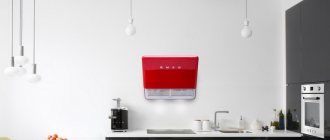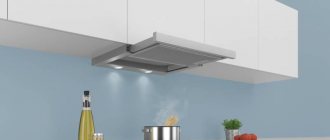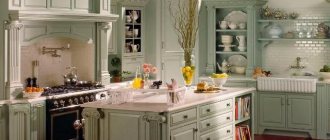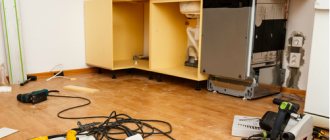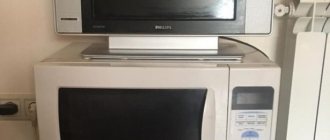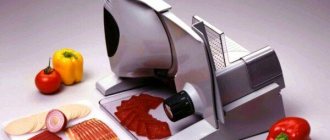In household appliance stores you can see similar devices of various types, but built-in devices are considered the most popular.
They can be hidden discreetly in the upper cabinet and will not disrupt the design of the kitchen, as well as save space.
In order for the hood to work well without failures, many parameters should be taken into account when choosing it.
We reviewed the best built-in kitchen hoods of 2021 in terms of price/quality ratio. The TOP is based on real consumer reviews and expert ratings. Among them, you will definitely choose a model that suits all parameters.
Rating of the TOP 20 best built-in hoods for the kitchen in 2020
| Place | Name | Price |
| TOP 4 best built-in kitchen hoods in price/quality ratio for 2021 | ||
| 1 | Faber Inca Plus HIP X A52 | Find out the price |
| 2 | ELIKOR Integra 60 black/black | Find out the price |
| 3 | LEX Hubble 600 Inox | Find out the price |
| 4 | Krona Kamilla 1M 500 white | Find out the price |
| TOP 4 best fully built-in kitchen hoods 60 cm | ||
| 1 | Krona Mini 600 white | Find out the price |
| 2 | Faber IN-NOVA PREMIUM X A60 | Find out the price |
| 3 | Krona Mini 600 inox | Find out the price |
| 4 | ELIKOR Integra 60 white/white | Find out the price |
| TOP 4 best built-in kitchen hoods 50 cm | ||
| 1 | ELIKOR Integra 50 white/white | Find out the price |
| 2 | Krona Kamilla 1M 500 black | Find out the price |
| 3 | ELIKOR Integra 50 black/stainless steel | Find out the price |
| 4 | GEFEST BO-4501 K20 | Find out the price |
| TOP 4 best built-in kitchen hoods 45 cm | ||
| 1 | ELIKOR Integra 45 black/black | Find out the price |
| 2 | ELIKOR Integra 45 white/stainless steel | Find out the price |
| 3 | Krona Kamilla 1M 450 inox | Find out the price |
| 4 | ELIKOR Integra 45 cream/cream | Find out the price |
| TOP 4 best built-in retractable hoods for the kitchen | ||
| 1 | Krona Kamilla 2M 600 black | Find out the price |
| 2 | ELIKOR Integra 60 black/stainless steel | Find out the price |
| 3 | Krona Kamilla 1M 600 black | Find out the price |
| 4 | Krona Kamilla Sensor 2M 600 inox/white glass | Find out the price |
What is a built-in kitchen hood
The hood is a unique invention that is capable of capturing grease, fumes, soot and odors during cooking in the kitchen, preventing them from spreading throughout the apartment and settling on kitchen furniture and walls.
Modern built-in hoods are designed for maximum space saving in the kitchen, while doing an excellent job of the task.
Any hood works on the principle of forced ventilation. Catching polluted air, it passes it through a filter installed inside the device, and thereby cleans it of grease, soot, combustion products and unpleasant odors. The purified air enters back into the room (in recirculation operating mode) or is discharged into the ventilation shaft (when installing a kitchen hood with ventilation outlet).
The filters that are equipped with each hood model, regardless of the manufacturer and type of device, are located inside the device body. On its front part there is a control module with an electronic, mechanical or slider panel.
All modern hoods differ in the method of mounting: built-in, dome and suspended.
The built-in kitchen hood is the most popular and in demand. It is mounted inside a wall cabinet, which is located above the hob, or in the countertop. This allows you to hide the device, which gives the kitchen completeness and harmony.
All modern models of hoods have several operating modes
Built-in hoods can be vertical or horizontal.
Helpful advice! A vertical hood is not inferior in its parameters to a dome hood. However, it is more compact and convenient to use.
Performance characteristics of built-in hoods
All models of built-in hoods differ in certain parameters.
The first parameter that you need to pay attention to is the size of the hood and the design of the retractable module. The built-in hood is completely hidden in a wall cabinet that has no bottom. The area of the hood's working area can be increased using a retractable screen.
If the kitchen set is already installed, then the device is selected based on the internal space of the wall cabinet where it will be located. Hoods come in various sizes ranging from 45 cm to 90 cm, which will not cause difficulty in choosing the required type and size for a particular case. However, we should not forget that the size of the hood should be similar to the dimensions of the hob. It is better if the exhaust device covers the cooking surface in its area, and not vice versa.
One of the new products on the forced ventilation market is a hood built into the stove, which is sold complete with a hob.
The 45 cm hood, built into the cabinet, is ideal for small kitchens with an area of 6 square meters. m., where the stove with 2-3 burners is located. Installation of a 45 cm built-in hood in a cabinet does not require additional steps related to adjusting the size of the furniture.
The 50 cm built-in kitchen hood has similar advantages. Its design is very compact and does not require any additional steps during installation. At the same time, the capacity of a 50 cm hood built into a cabinet does not exceed 400 cubic meters. m. per hour. Therefore, it will not be possible to fully clean a medium-sized kitchen using a 50 cm wide hood.
Standard sizes of hobs require the use of 60 cm built-in kitchen hoods. They are able to provide the necessary performance thanks to powerful motors, which is ideal for kitchens with an area of 9 square meters. m. At the same time, such a hood significantly saves space due to its design.
For a large kitchen, 12 sq. m or more, a built-in hood for a 90 cm kitchen is ideal. It is also installed above a large stove with 5 burners.
Depending on the hood model, built-in filters can be disposable or long-term use
All built-in hoods are equipped with a filtration system. Air purification can occur in one or two stages.
Flow hoods are equipped with a mechanical filtration system without installing a carbon filter. Here, polluted air is cleaned of combustion products, fat and soot. Most models are equipped with a steel or aluminum filter, which require regular cleaning as it becomes dirty. It does not require replacement. Its service life is unlimited and reaches the period of operation of the hood. Disposable filters are a replaceable plastic cassette with a synthetic filler, which can be padding polyester or non-woven fabric.
Models that operate in recirculation mode are required to be equipped with a disposable carbon filter. It is he who is able to neutralize extraneous unpleasant odors that are formed during cooking. This filter requires regular replacement. After the end of the operating period, after 3-6 months, which depends on the intensity of the device’s operation, it is necessary to replace the carbon filter for the hood, which can be purchased at any household appliance store at a price of 1.5 thousand rubles.
Built-in hoods can be with one or two motors. This affects the quality of air purification, the performance of the device and the noise level during its operation. The more performance the hood requires, the more powerful its motor will be. And this affects the noise level, which will also be higher. Typically, built-in hoods are equipped with medium-power motors to reduce the overall noise level of the device.
The built-in hood not only allows you to keep the kitchen clean, but also economically illuminates the work area above the hob
The performance of the device determines the total amount of polluted air that can be purified per unit of time. It's very easy to calculate. It is necessary to multiply the volume of the room by a factor of 10 or 12, which indicates the air exchange in the room per hour. This value will correspond to the minimum performance required for this room.
Helpful advice! Another 20% should be added to the minimum performance value and the device should be selected based on the obtained value.
Additional features of exhaust devices
On the front of the hood body there is an electronic module panel that controls the hood. In turn, the panel can be push-button, touch-sensitive or slider-based. Regulation of the operating modes of the hood with a push-button control system is carried out by switching the button. The slider panel involves moving a mechanical slider to a place that corresponds to the required operating mode. Touch control is carried out by touching your finger on the desired area. When the command is accepted, the LED on the panel lights up.
Some hood models have additional functions, such as a built-in player, clock, LCD display and others
Modern hoods are equipped with many additional functions that are aimed at facilitating their operation and creating additional comfort. The device may have an interval switching function, thanks to which the hood periodically turns on independently, providing an influx of fresh air into the room. The hood can be equipped with a residual speed function, which allows the fan to continue to operate for some time after the hood is turned off. This allows you to achieve ideal purification of polluted air.
More expensive modern models are equipped with an LCD screen with the ability to connect a DVD player or PC, and a meteorological system, which allows you to display the weather forecast on the display. This is done thanks to a weather station, which is located outside the house and connected to the hood.
Types of built-in kitchen hoods
One of the important criteria by which all models of built-in hoods differ from each other is the design of the device. There are fully built-in, visor and telescopic hoods.
Depending on the interior of the kitchen, you can choose an interesting design hood built into the wall, but such a solution requires planning at the renovation stage
Fully built-in devices are ideal for small kitchens. The hood is completely mounted in a wall cabinet or countertop, without taking up free space or attracting attention to itself, as can be seen in the photo of built-in hoods that complement any room design. Such a device can be equipped with a carbon filter, which will allow the hood to operate in recirculation mode.
The design of a telescopic hood involves increasing the working area by moving the surface of the device forward. This option provides greater extraction performance and makes it easier to control this device.
All built-in hoods are divided into flow and recirculation. Flow-through systems must be additionally equipped with an air vent that connects the hood to the ventilation hole. They are more expensive, but have greater productivity. Recirculating hoods pass air through a system of carbon filters and return it back into the room. They do not require additional costs for installing an air exhaust system into the ventilation of the house.
An example of a mobile recirculating hood equipped with powerful carbon filters
There are models with recirculation mode of operation that can provide efficient operation, but this entails a high cost of the device and high energy costs associated with its operation.
Helpful advice! For large kitchens, you should choose hoods with air exhaust into the ventilation.
There are models that can operate in two modes. Air purification occurs using a grease filter, which frees the air from harmful impurities, and a carbon filter copes with unpleasant odors. Then the purified air can be discharged into the ventilation system through the air duct, or can be returned back into the room. Depending on the type of activity in the kitchen, you can switch to the required operating mode of the device.
Which built-in hood to choose?
To choose the best hood in 2021, you need to pay attention to the following parameters:
- Filter . Almost all hoods have a grease filter. It protects the engine, fan and other parts of the grease extractor.
- Number of speeds . It is better to choose a device with a large number of speeds.
- Engines . Many hoods have one motor, which directly affects the suction power.
- Productivity . The most important parameter that determines whether the device will cope with the created steam.
- Power . It depends on the type of engine. The range of this parameter is presented from 100 to 290 W.
- Noise level . All models are characterized by high noise, but a level of up to 50 dB is considered optimal.
- Frame . All hoods are made of stainless steel. This is a durable material that ensures reliability and durability.
- Type of control . The device can be controlled mechanically and electronically. The first option is considered the best, since the electronic display may not work as well due to fat sticking to it.
- Lighting . The hood can be equipped with lamps that differ in power and brightness.
Review of popular brands and photos of built-in hoods in kitchen interiors
The cost of the hood is affected by the functionality and appearance of the device. If you choose from budget options, then you should give preference to hoods from such manufacturers as Krona, Elikor, Hansa, Gorenje, Teka, which produce mainly built-in hoods of 50 cm and 60 cm. On average, an exhaust device can cost 3-8 thousand rubles, but its productivity will not exceed 450 m³/h.
Many users choose Teka brand hoods because, if desired, it can be easily mounted into a set
For example, a built-in kitchen hood 50 cm Hansa fits harmoniously into any kitchen interior, does not make unpleasant noise during operation and does an excellent job of cleaning the air in small spaces. The average price of the model is 2.5 thousand rubles.
The built-in hood Krona 50 can be easily installed in any wall cabinet and can operate in recirculation mode or with air exhaust into ventilation. The price of the device is 3.5 thousand rubles.
More expensive brands are Bosch, Lex and Electrolux. They produce the quietest hoods, in which the noise level does not exceed 45 dB. At the same time, the productivity of such hoods reaches 800 m³/h and higher. The cost of equipment depends on its power and ranges from 11-40 thousand rubles.
Electrolux hoods are among the quietest, while having quite high power
If you need to choose a non-standard built-in 90 cm hood, which is suitable for large kitchens, then you should give preference to such well-known brands as Bosch, Gorenje, Electrolux, Siemens and Hansa. Manufacturers have taken care of a wide range of 90 cm kitchen hoods, which vary in power, design and functionality. The minimum productivity of such devices is 650 m³/hour. The cost ranges from 14-25 thousand rubles.
You can choose budget models of built-in hoods 90 cm. For example, a built-in Krona hood with a capacity of 550 m³/hour will cost about 9.5 thousand rubles.
A telescopic hood with slider control and recirculation mode Cata, with a capacity of 600 m³/hour costs 9 thousand rubles.
Thanks to their compact size, Gorenje hoods are almost invisible, but at the same time quite powerful
Types of hoods
Let's figure out what types of hoods exist. This will help you understand which hood is right for you.
Classic hood
This hood is small in size and should not be placed above the stove. It can be placed openly or hidden in a closet. The classic hood is considered the most affordable due to its low cost.
Built-in hood in the kitchen
The main advantage of a built-in hood in the kitchen is that it is not visible and, accordingly, it does not spoil the view. This hood is installed directly in the cabinet above the stove. A built-in hood is the best hood for a small kitchen where every centimeter is important.
Read: Apron for the kitchen, all types of aprons, description (120 photos)
Dome hood
The hood is installed in a hanging position above the stove. There are various forms of dome hoods. In addition, the dome hood can be either straight or inclined. Inclined hoods are currently very popular.
Advantages of an inclined hood:
- Silence
- Compactness
- Touch control
- Easy assembly
Having purchased such a hood, you will not be faced with the question “How to install a hood”, because... you can easily do this yourself.
Retractable hood
The second name for this hood is telescopic. Using a special mechanism, it extends above the stove. They take up little space and are not connected to the air duct.
Island hood
This hood is attached to the ceiling and directly above the stove. If the ceiling is high, then you need to buy a more powerful hood. This hood is well suited for private houses with high ceilings.
Types of retractable hoods
Telescopic or retractable kitchen hoods have two main designs. According to the method of air purification, they are divided into filtering and exhaust.
The principle of operation of filter hoods is to pass contaminated air through special filters located inside the structure. The purified air returns to the kitchen area. Most modern models use a two-level filtration system, which ensures efficient operation of the device. When operating such a hood, it is not at all necessary to provide air flow; the window can be kept closed, which does not disturb the temperature regime in the room. A filter type hood can be installed in any convenient place in the kitchen.
Diverter hoods use a different operating principle. They remove polluted air from the room through the ventilation system. Such hoods are located only near the ventilation opening and are connected with special air ducts. Devices with this operating principle are the most powerful and efficient, but during their operation it is necessary to ensure air flow into the room.

